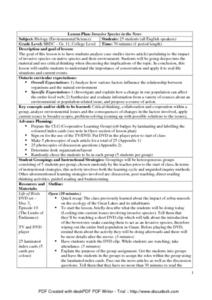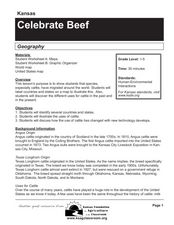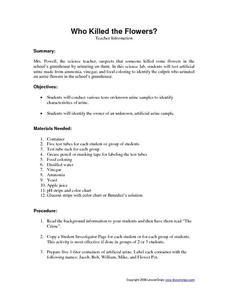Curated OER
Beautiful Bovine
Students compare and contrast a human body to a cow. Using a diagram, they label and identify the functions of the cow's numerous parts. In groups, they create a Venn Diagram to compare the various types of cows with one another. They...
Curated OER
Invasive Species in the News
Students explore how invasive species can change an environment. For this critical thinking lesson, students study how invasive animals can change an environments population. They will discuss the implications of an invasive species and...
Curated OER
For Creative Minds
Students study pictures of plants, animals, and minerals. Students classify the pictures into the three groups. In this rock identification lesson, students complete a rock finding lab experiment by finding, cleaning, identifying, and...
Curated OER
Microbe Experimentation
Seventh graders study microorganisms in their environments by experimenting with milk products. In this microbes lesson, 7th graders read background information about microorganisms in yogurt and soured milk. Students then follow a...
Curated OER
Making Molecules
In this molecules worksheet, students combine different food colorings that represent atoms to make different molecules. Students read 7 directions and answer 2 questions.
Curated OER
We All Need Trees
Learners complete a guessing game. In this tree products instructional activity, students view various household items and try to determine if they were made from trees. They discuss their findings and then read books about trees.
Curated OER
The Solar System: Why do we Explore?
Third graders act as scientists. In this property discovery lesson, 3rd graders explore the substance "Oobleck" (cornstarch, water, food coloring). They work in groups to investigate the substance and make observations as a scientist...
Curated OER
Celebrate Beef
Young scholars read about the history of cattle, discover new technologies, and fill out worksheets about cattle use. In this cattle lesson plan, students identify states that raise cattle and draw pictures of how cattle is used.
Curated OER
By Golly By Gum
Students identify the different steps in the scientific method. In this inquiry lesson plan, students determine the mass of the gum after chewing it for sometime. They explain what happens to the lost mass.
Curated OER
Earth Epochs
Students explore earth epochs, i.e, Permian, Precambrian, Cambrian, Ordivician and through pictures they see what life on Earth and animals looked like. They organize Earth Epochs according to years going from greatest to least...
Curated OER
Five a Day
Students look up and print definitions of fruit and vegatable. They write down their food intake for three days. They identify and categorize fruits and vegetables. They research how fruits and vegetables grow. They bring in their...
Curated OER
Eggs
Students know the following parts of an egg as the yolk, white, shell, membrane, chalaza, and air sac. They also sequence the growth of the chick in the egg. An egg is broken and students touch, smell and see it. They locate the six...
Curated OER
Growing Jack and the Beanstalk Plants
First graders investigate how plants grow by growing their own "beanstalk", (after reading "Jack and the Beanstalk") and record their observations daily in a science journal.
Curated OER
Observing Plants
Students identify how plants affect the survival of a caterpillar and what plants need to survive. They plant three bean seeds in the three containers, placing two containers at a sunny window and the third one in a dark closet and label...
Curated OER
Arabian Camel or Dromedary
In this camel worksheet, students study the diagram for an Arabian camel otherwise known as a dromedary. Students read the characteristics of the animal and may click on associated links to learn more.
Curated OER
The Young Virginia Gardener:Growing Seeds Indoors
In this gardening worksheet, learners read about growing seeds indoors, then complete 4 short answer questions based on the passage.
Curated OER
The Mind-Body Connection
Second graders learn about the human body. In this biology lesson plan, 2nd graders will begin with the basics of understanding charts and graphs and progress into units that cover the body systems, and mental and emotional health....
Cornell University
Beneficial Insects
A lot of people think of insects as pests. But actually, some insects are beneficial because they get rid of pests! After learning about beneficial insects, class members research given insects to find out if they are pests or predators.
American Chemical Society
Using Color to See How Liquids Combine
Blue-tinted water is added to unknown liquids that have been tinted yellow to find out how they interact. This is a memorable activity that is part of an investigation on the properties of liquids, which is part of a unit on the...
American Chemical Society
Using the Combining Test to Identify Unknown Liquids
Once investigators have learned how their mystery liquids interact with water during the preceding activity, they now use their observations to identify them. This is an ideal conclusion to the mini unit on the properties of water.
Lesson Snips
Who Killed the Flowers?
This could be really good, or it could be really bad! The crime to be solved is, "Who went pee in the flowerpot?" Given four imitation urine samples, young chemists or crime scene investigators perform pH, glucose, and turbidity tests to...
ARKive
Plants
Here is a one-hour activity that helps learners remember the parts of plants. Not only will the class learn about plant parts, they'll also discuss seed dispersal and plant growth. A celery experiment is used to show how plants obtain...
Curated OER
A Visit to Price Chopper
Students visit the grocery store to purchase items to make trail mix which are connected to Kansas agriculture. They problem solve to determine which products to buy, then create, advertise and sell the trail mix to the student body...
Curated OER
Galileo's Thermometer: Measuring the Density of Various Unknown Liquids
Sprouting scientists explore the concept of density by making mass and volume measurements for five different liquids. From these measurements, they calculate densities. They apply their learning to explain Galileo's thermometer works...

























